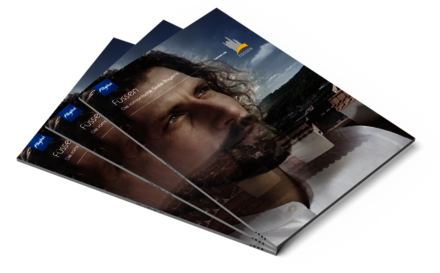Hohenschwangau Castle
What is known today as Hohenschwangau Castle was first mentioned in documents in the 12th century as Schwanstein Castle. The building was owned by the Knights of Schwangau until the 16th century, after which it changed hands frequently. Schwanstein Castle was severely damaged several times during the various wars of this period.
As a result, the Bavarian Crown Prince Maximilian - later King Maximilian II- came across a ruin that nevertheless fascinated him. From 1833 to 1837, he had it rebuilt into a castle in the neo-Gothic style. The interior is adorned with numerous murals with themes from the world of medieval legends. The motif of the swan is omnipresent. Maximilian II, his wife Marie and their children Ludwig and Otto used Hohenschwangau Castle primarily as a summer residence. The royal family loved summer retreats in the mountains and were all passionate hikers. Ludwig II and his younger brother Otto spent most of their childhood and youth at the castle near Füssen. The royal family's favorite trails can still be discovered today.
Visit
The Museum of the Bavarian Kings is located directly on the Alpsee below Neuschwanstein Castle and Hohenschwangau Castle. It shows the history of the Wittelsbach dynasty and its Bavarian kings. The Calvary, which is located behind Hohenschwangau Castle, is also worth a visit. Halfway up is the Marienkapelle chapel with an impressive, life-size statue of the Virgin Mary.
The castle can only be visited as part of a guided tour.
Tickets are availableonline from the Ticket Center Hohenschwangau .
Hohenschwangau Castle can be reached from Hohenschwangau on foot or by horse-drawn carriage.

Information about the castles
You can find comprehensive information about visiting the royal castles of Neuschwanstein and Hohenschwangau in our "Castle information" flyer.
Hohenschwangau Castle is open:
- April 01 to October 15: daily from 9 a.m. to 5 p.m.
- October 16 to March 31: daily from 10.00 a.m. to 4.00 p.m.
Closing days: 24.12.24, 25.12.24, 31.12.24, 01.01.25
Tickets are available online and at the Hohenschwangau Ticket Center (limited daily quota).
Visits are only possible as part of a guided tour!
- Regular ticket 23,50 EUR
- Reduced price 19.50 EUR(information on discounts)
- Children (7-17 years) 12,00 EUR
- Children (0-17 years) free of charge
- Information on combined tickets(with Neuschwanstein Castle and/or the Museum of the Bavarian Kings)
The ticket prices do not include an advance booking or handling fee of EUR 2.50.
- By public transportation: Bus routes 73 and 78 run from Füssen railroad station to Hohenschwangau. Please note that the buses can be very full, especially in the summer months between July and September. Although additional buses are operated, delays can still occur. We recommend that rail travelers allow a sufficient buffer between bus and train journeys.
- On foot or by bike: The shortest route from the Tourist Information Füssen to the Ticket Center in Hohenschwangau is 3.8 kilometers. The paved footpath or cycle path runs parallel to the road connection between Füssen and Hohenschwangau. Alternatively, there is a beautiful hiking route via the Alpenrosenweg to Hohenschwangau. Various signposted footpaths lead from the Ticket Center in Hohenschwangau to the gate of Hohenschwangau Castle.
- From the Ticket Center by horse-drawn carriage: The route from the Ticket Center to Hohenschwangau Castle can also be covered by horse-drawn carriage. In this case, the last section of the route to the castle must be covered on foot (approx. 5 minutes). The following prices apply for the transfer to the castle: Horse-drawn carriage: Ascent: 5.50 EUR / Descent 3.00 EUR
- By car: Leave Füssen via Bundestraße 16 in the direction of Schwangau. After the Lech bridge, turn right at the second intersection towards Hohenschwangau and follow the road to the signposted parking lots. Please note that the road to Hohenschwangau Castle is marked as "Königsschlösser" on the traffic signs. We strongly recommend that you park your vehicle in one of the paid parking spaces. Parking is prohibited on the roads near the castles. The official parking lots cost between 12.00 and 16.00 EUR per day for cars.
It is generally possible to visit Neuschwanstein Castle with reduced mobility. During a regular tour of Neuschwanstein Castle, there are a total of approx. 90 steps to negotiate. There is no visitor elevator in the castle. If you have limited mobility, please contact the Ticket Center in Hohenschwangau in advance
(Phone: +49 8362 9308-30 or e-mail: info(at)ticket-center-hohenschwangau.de).
Photography around the royal palaces is permitted for private purposes.
Indoor photography is prohibited.
You can find more details about Hohenschwangau Castle with all FAQs at the Ticket-Center Hohenschwangau.
Contact Ticket-Center:
Phone: +49 8362 9308-30
E-mail: info(at)ticket-center-hohenschwangau.de
Leaflets and flyers
View, download or order brochures, local maps and leaflets.





